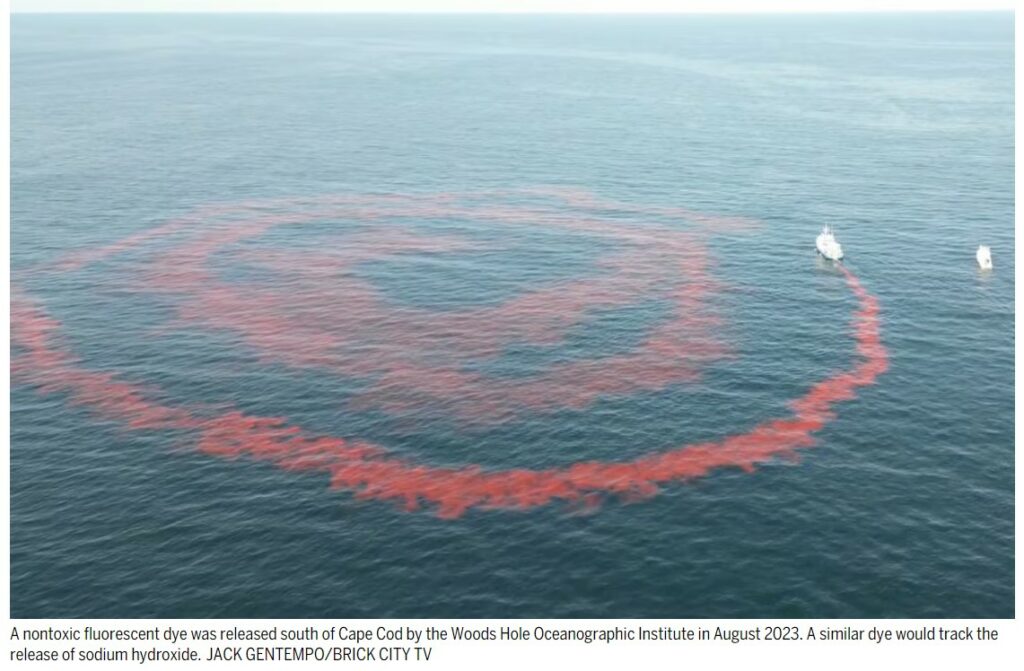Chemical Sequestration of Atmospheric CO2 through Alkalinization
Testing Oceanic Carbon Capture
I’ve mentioned previously the hypothesis that iron fertilization of the ocean and consequent phytoplankton blooms is one feasible method to achieve global carbon capture. Small-scale experiments have been done already. The results have been mixed insofar as documenting the scale of phytoplankton blooms, but there has been no reported harm.
Another strategy relies on chemical sequestration of atmospheric CO2 through alkalinization of surface seawater. The ocean is a well-documented sink for CO2, which freely exchanges at the surface. A consequence of dissolved CO2 is acidification, and the lower the pH, the less CO2 can be dissolved. So the theory is that raising ocean pH on a large scale will sequester more CO2 as stable bicarbonate.
“That is the basic hypothesis behind a controversial geoengineering experiment planned by scientists at the highly respected Woods Hole Oceanographic Institution, a private marine research non-profit organization.
“The scientists are awaiting federal approval to release a 6,600-gallon mixture of sodium hydroxide solution and freshwater into the open ocean 10 miles southwest of Martha’s Vineyard in a first-of-its-kind trial scheduled for September. If that test goes well, then next summer, scientists would conduct an even larger experiment 10 times the first amount — 66,000 gallons — into the Wilkinson Basin, a deepwater section of the Gulf of Maine about 50 miles east of Gloucester.”
Of course, neither the Woods Hole scientists nor the EPA are ignorant, naïve, stupid or corrupt. Woods Hole won’t profit financially from a positive outcome. They acknowledge the potential risks to local wildlife and will be monitoring this experiment closely. Think of this as a phase I clinical trial for a new drug or vaccine; a small scale trial for safety, not efficacy. If a therapy fails phase I, it doesn’t progress to further stages. Same with ocean chemistry engineering.
“Some scientists caution, however, there are dangers to marine life. Even a relatively small amount of sodium hydroxide solution released in the ocean will result in killing “foundational” marine life, including phytoplankton, zooplankton, and fish larvae, and displacing or injuring other creatures due to the huge spikes in alkalinity, said James Kerry, an adjunct marine scientist at the James Cook University in Australia.
“I see it, essentially, as trying to address one form of marine pollution — carbon dioxide — with another” pollutant, said Kerry, who is also a senior marine and climate scientist for OceanCare, a marine conservation nonprofit organization based in Switzerland.
“In a statement, EPA spokesperson Angela Hackel wrote the agency is consulting with the National Marine Fisheries Service and US Fish and Wildlife about potential impacts to fish habitats and endangered species as part of the permitting process.
“Geoengineering research has attracted enthusiastic venture financing in recent years, and is oft criticized by opposing groups as overly hyped. But the Cape scientists leading the project point out the experiment is not being pursued by a start-up company with profit in mind, but by a research institution with a legitimate scientific question: Could this work?
“Even if it does, both geoengineering researchers and critics agree that carbon dioxide removal technologies are alone not enough to combat climate change. While it may help on the margins, most agree it cannot be a replacement for the massive cuts needed to reduce greenhouse gas pollution.”
Stay tuned!
Ocean geoengineering experiment for CO2 squestration, Boston Globe

